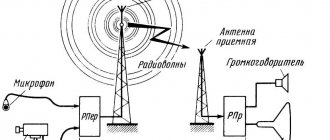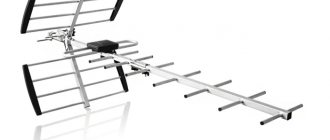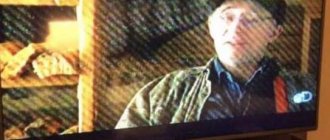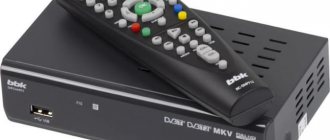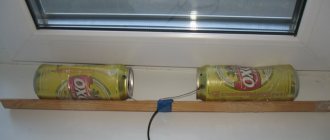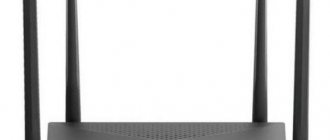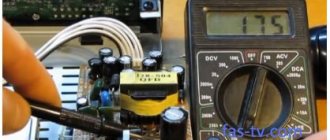There is an active transition to digital television across Russia, for which everyone who owns a TV will have to prepare in one way or another. The lucky ones are the owners of modern “TV boxes” that can receive a digital DVB-TV2 signal. All you need for the transition is a decimeter antenna. If you have long wanted to disconnect from the collective antenna so as not to pay extra, today we will tell you how to choose an individual indoor antenna for digital TV. Which is better? Let's figure it out together and suggest popular models.
How to choose an indoor antenna for digital television?
The indoor version of the antenna for digital TV is definitely the most economical. Indoor antennas, commonly called "horns" in everyday life, cost on average 800-900 rubles - buying one will not be a problem even with the tightest budget. And, of course, you don’t need to pay a subscription fee for them.
You should choose an indoor antenna based on several parameters - it’s good that there are only two mandatory ones:
- Ability to receive decimeter waves (UHF, UHF) . This is the first mandatory condition. Without it, you simply cannot catch the “digital” signal, since it broadcasts in the decimeter range.
- Capable of receiving DVB-T2 signal . This is the second mandatory condition, because it is according to this digital signal standard that Russian digital TV broadcasts.
The remaining parameters are left to your choice:
- Active or passive power supply . The active antenna is connected to a separate outlet. Passive - powered directly from the TV. The first option allows you to get a more powerful signal, the second is more aesthetically pleasing and economical in terms of electricity consumption.
- Availability of a signal amplifier . If you live close to a TV tower, you don’t really need an amplifier - the signal is already very strong. But if you want to take the antenna to your country house, live in a village, on the far outskirts of the city, or vice versa - in a densely built-up central area, you cannot do without amplification.
- Amplifier power . The further you are from the television center, the more powerful amplifier you need. 30-40 dB is the required minimum if you want to get a good signal at a distance from the source.
- Possibility of receiving FM . 20 channels and 3 radio stations broadcast in digital format. Having an FM receiver will allow you to listen to digital radio.
As you can see, an indoor antenna is a fairly simple device, the choice of which is not difficult. To make it even easier, we have compiled a ranking of indoor digital TV antennas that are popular in 2021.
The best indoor TV antennas with amplifier
Many users ask the question of how to choose a home antenna for TV if it is located far from the television center. In this case, you should buy an antenna with a built-in amplifier and not worry about the quality of signal reception, possible interference or freezes. Below we consider the best models of indoor antennas with amplifiers of 30-40 dB.
The top indoor antennas with an amplifier for digital TV consists of:
Locus L 941.10 CAYMAN
The indoor active antenna of the “Cayman” series is used to receive signals in the DVB-T/T2 digital format. A compact and convenient log-periodic antenna with a built-in amplification unit picks up a signal from the tower within a range of 20 km. If necessary, connect a power supply device of the LI series if the set-top box does not produce five volts (but most DVB-T2 set-top boxes have a 5 V power supply at the antenna socket).
| Characteristic | Meaning |
| Frequency range | 470-860 MHz |
| Gain indicator | 11-18 dBi |
| Dimensions | 268x300x85 mm |
pros
- does not require an external power source;
- stable design - do not accidentally turn over;
- high signal level gain – 40%;
- low cost;
- good workmanship.
Minuses
- no support for omnidirectional reception;
- unreliable plug.
Review: “I was very pleased with the result; if before the picture disappeared endlessly, the image crumbled, the signal was lost, but nothing like this has happened since the purchase.”
HARPER ADVB-2969
A desktop functional indoor antenna for digital TV with a built-in amplifier provides an excellent signal level, eliminating all possible interference. The black plastic antenna housing with a power indicator emphasizes its modern, laconic design. For simple and convenient control, it is equipped with a gain control. The antenna can receive analog and digital signals in the VHF and UHF bands, as well as FM radio signals from ground stations.
| Characteristic | Meaning |
| Frequency range | 470-862 MHz |
| Gain indicator | 30 db |
| Dimensions | 150x150x203 mm |
pros
- presence of a control regulator;
- one year warranty from the manufacturer;
- low noise level – up to 3 dB;
- LED operating status indicator;
- adjustable extendable antenna.
Minuses
- The cable length may not be enough - only 1 m;
- high price.
Review: “Beautiful design, small, inexpensive. We bought it because the receiver was broken, we decided to try its alternative, we thought it would work worse, but it turned out to be the opposite. The image quality is clear."
Selenga 101A
This antenna guarantees a stable digital terrestrial television signal in the reception area. Operating parameters (range and reception quality) depend on many criteria: antenna installation location, terrain, time of year and LTE interference level. The power source for antenna 101A is a set-top box or TV. The design of the device in a minimalist style is suitable for those who do not want to see classic “horns” in the room.
| Characteristic | Meaning |
| Frequency range | 174-862 MHz |
| Gain indicator | 33.0 dBi |
| Dimensions | 190x110x8 mm |
pros
- clear, high-quality image transmission - without interference;
- stylish design;
- ease of installation and use;
- portability;
- You can connect directly to the antenna connector or through the receiver.
Minuses
- weak signal in the private sector;
- short cord.
Review: “Quite high-quality display of all declared digital terrestrial channels in the area of reliable reception, even without additional power. Original compact design. Relatively low cost."
REXANT RX-267
An active indoor antenna is designed for receiving digital terrestrial broadcasting on modern televisions or combined receivers equipped with a DVB-T2 tuner. It picks up a signal from a TV transmitter at a distance of up to 25 km, so it is perfect for areas moderately remote from the tower, for example, a summer house or a suburban house. The two-meter antenna cable allows you to install it in the desired location without using an extension cord.
| Characteristic | Meaning |
| Frequency range | 470 – 862 MHz |
| Gain indicator | 26 dBi |
| Dimensions | 270x350x120 mm |
pros
- low price;
- does not distort the image and sound;
- compact dimensions;
- long cord;
- large range of action.
Minuses
- without power supply, the antenna does not work;
- Chinese production.
Review: “Classical log-periodic antenna, 20 km to the tower – reception is 5 points, I have a wooden one-story country house, the antenna is on the TV.”
HARPER ADVB-1420
A small indoor antenna with an active amplifier provides a good signal level without loss. It is used to work with digital television signals and for analogue bands with VHF frequencies 87.5-230 MHz. To improve the signal quality, it is not necessary to rearrange the device - you can separately change the position of either the telescopic guides or the loop antenna. This device allows you to view open digital channels without paying subscriptions and tariffs.
| Characteristic | Meaning |
| Frequency range | 470-862 MHz |
| Gain indicator | 30 dB |
| Dimensions | 183x234x130 mm |
pros
- possibility of independent installation and connection;
- interesting design;
- there is a power regulator;
- desktop;
- receives FM signal.
Minuses
- plastic case;
- indicator is too bright.
Review: “It turns out that in order to get reliable digital signal reception and high-quality images, you don’t need to buy a large antenna and special equipment. Such a small antenna with a signal amplifier is quite enough for this.”
REMO BAS-5340-USB TVJET
Wideband active indoor antenna is ideal for working with the TVJET RE820HDT2 digital receiver. A device with a classic log-periodic structure guarantees high-quality images without sagging. The new integrated amplifier provides high signal reception performance. The amplifier can be powered from the USB output of the TV, a charger with a USB output, or a receiver.
| Characteristic | Meaning |
| Frequency range | 470 – 862 MHz |
| Gain indicator | 23-43 dBi |
| Dimensions | 270x350x120 mm |
pros
- made of high-strength safe materials;
- the design is designed specifically for installation on a window sill;
- stylish appearance;
- micro-corrugated cardboard packaging protects the antenna from damage during transportation;
- Sufficient cable length is 1.8 meters.
Minuses
- no power supply;
- the distance from the tower is no more than 10 km.
Review: “Good antenna, one of the best and most powerful! But the fastenings at the stand are very weak; these small plastic ears always break when trying to connect to the antenna.”
Ritmix RTA-101 AV
A telescopic rotating indoor TV antenna with an amplifier provides high-quality reception of analogue and digital television signals, as well as radio signal reception. The device recognizes various digital HDTV standards for broadcast television and radio. Two telescopic "whiskers" and an omnidirectional grille maintain stable reception. The built-in active amplifier with the ability to regulate will delight you with your favorite content in good quality even with a weak terrestrial TV signal.
| Characteristic | Meaning |
| Frequency range | 470 – 862 MHz |
| Gain indicator | 32 dB |
| Dimensions | Length 600 mm |
pros
- adjustable height of telescopic antennas;
- the grid is responsible for signal stability;
- support for various bands - VHF, UHF, DAB and FM;
- manufacturer - a famous Korean brand of portable electronics;
- variable tilt angle.
Minuses
- external power supply is required;
- high price.
HARPER ADVB-2120: the most purchased model
HARPER ADVB-2120 antenna the best indoor antenna for digital TV according to customers. It receives a DVB-T2 signal in the VHF/UHF wavelength range, as well as FM radio. The antenna is of the passive type and is equipped with a 30 dB amplifier over the entire received range.
Customer feedback on the antenna is positive: it easily picks up both digital TV multiplexes at a distance of 30-35 km from the TV tower and is very compact, since it does not have a power supply. The disadvantage of the antenna is its narrow stand, due to which it periodically falls.
How to connect a TV antenna
Most indoor TV antenna models come with a cable and antenna connector. Developers design their products more for ideal reception conditions, so the cable of factory models has a limited length (up to 1.5 m) and is not of the best quality. In the case of digital reception, you are unlikely to be able to create a spectacular picture: a TV with a compact antenna next to it or on it. If your TV is not installed near a window where it would be advisable to place the TV signal receiver so that it can better pick up the “digital” signal, then you will have to add a cable. This plus several meters of cable extension and one additional connection, and, as a result, some signal attenuation.
How to connect an indoor antenna to a TV
For the lucky ones whose TV can independently receive T2 television, just insert the plug into the TV socket. What and how to configure in the menu? You need to select “digital signal” in the TV menu. Indoor antennas with an amplifier must be connected to the electrical network; do not forget to connect the adapter to the outlet before starting “Autosearch”.
How to connect to a set-top box
If you don’t want to change your TV that’s not too new, but works well, then don’t. Buy an additional digital receiver for your TV and connect it correctly.
Carefully unpack the TV antenna and place it on a window that faces the TV tower. Before this, you inserted the plug into the corresponding socket on the TV. Now your task is to insert it not into the TV, but into a brand new, recently purchased digital terrestrial tuner. The processed television signal from the audio-video output of the tuner is fed to the audio-video output of the T2 receiver. If you have a passive indoor antenna, then the connection ends there. You can proceed to searching and setting up TV channels.
You may be interested in: Connect a monitor to a digital TV set-top box
When connecting a TV antenna with an amplifier, do not forget to connect the amplifier adapter to the power supply. This must be done after all cable connections. A voltage of 5 volts can be supplied to the amplifying microcircuit directly from the receiver and no additional wire is needed. Afterwards you need to activate the power directly from the set-top box menu. Go to the menu, go to the settings section and find the “5V power” item, select “ON”, and click “OK”.
BBK DA20: neat design
The BBK DA20 indoor antenna will fit into any interior. A simple plate antenna picks up a DVB-T2 signal in the VHF/UHF bands. The antenna is equipped with a 22 dB amplifier, but does not have radio reception capabilities. The device is an active type, so you should take care of an outlet to power it.
The main advantage of the antenna is its design: it can be placed on any shelf, cabinet or other surface (depending on the location of the outlet), and it will be almost invisible. True, the device weighs a whole kilogram, so you will have to take care of a fairly stable shelf.
Main types of antennas
The classification of antennas for a TV is carried out in accordance with the location of the device. There are two main groups - for outdoor installation and for indoor installation. Today we will consider the second type, which is also divided into subgroups in accordance with design features and wavelength. There are a total of five types of indoor TV antennas.
Meter antennas are the simplest option. Devices of this type are designed to receive wave signals from television towers located in the meter range. They are presented in the form of a structure that consists of a stand (it contains a transformer and 2 movable “antennae”) and a coaxial cable necessary for connecting to the TV.
A meter TV antenna can show excellent results only if it is installed as close as possible to the signal source. Devices of this type are in little demand among users. Almost all channels have given preference to the digital format of television broadcasting. Using a meter antenna you can tune in no more than 5 Russian TV channels.
The second type is a frame or decimeter television antenna. From the name it is clear that this device is designed to operate in the UHF range. The design is presented in the form of a device with an open base, as well as a cable for connecting to a TV or receiver. This receiver provides an excellent signal if it is located within a radius of up to 30 kilometers from the TV tower.
All-wave or hybrid TV antenna. Particular attention should be paid to the versatility of the device. The device allows you to pick up signals in the meter and decimeter range. Using a hybrid antenna is extremely convenient, since the user has the ability to switch between bands if the need arises.
The fourth type is a passive TV antenna. This is an ordinary device for receiving a signal. There are no additional functionality. Passive type devices are not equipped with an amplifier. Therefore, achieving effective signal reception and tuning of TV channels without interference will be extremely difficult.
The last group is an active TV antenna. Unlike the previous type, this device is equipped with a special amplifier. This helps to significantly improve the quality of the received signal. Active receivers are used in situations where the TV is located quite far from the TV tower. The device can also be used to split the signal into multiple TVs. However, this will cause a deterioration in the quality of reception.
Now you know what indoor TV antennas are. They are mainly used to set up digital television. The “plate” is not installed indoors. Installation of satellite dishes is carried out on the roof of the house.
Delta K131A.03: powerful amplifier
Delta K131A.03 device is equipped with good DVB-T2 signal amplification capabilities. It operates only in the UHF range, but is capable of amplifying the signal up to 40 dB and at maximum provides stable reception even far from a TV tower. The antenna is active, which is dictated by the need to feed the amplifier.
According to customer reviews, the antenna is a lifesaver even in hopelessly built-up areas where the signal is interrupted by the walls of other houses - just twirl with it a little near the window, setting the gain to the desired level. In addition, it is compact and lightweight, despite being made of durable steel.
The best satellite dishes for a summer residence
Structurally, these antennas are large parabolic housings with a feeder (in common parlance - a “gun”), operating on the principle of focusing waves of a certain frequency range. Such models are capable of receiving signals from satellites, which eliminates the occurrence of “natural” interference in the form of forests, high-rise buildings, mountains, etc. This feature of antennas is ideally suited for buildings remote from large urban centers, including summer cottages. Satellite receivers are somewhat more expensive than terrestrial models, but in the vast majority of cases they are much more stable.
Hyundai H-TAI360: signal stability
This antenna is almost identical in capabilities and price to the top seller from HARPER, but is of the active type. Hyundai H-TAI360 provides VHF/UHF and FM reception, catches the DVB-T2 digital signal and amplifies it with a factor of 30 dB in all bands. The only thing is that it has a less successful (but more stable) design, reminiscent of flying saucers.
What buyers really note is the stability of signal reception by the antenna. She confidently picks up two multiplexes and a radio, the picture goes on without interruption, the sound is synchronous with the video. Moreover, the reception is not at all affected by bad weather conditions or the location of the house in the private sector.

